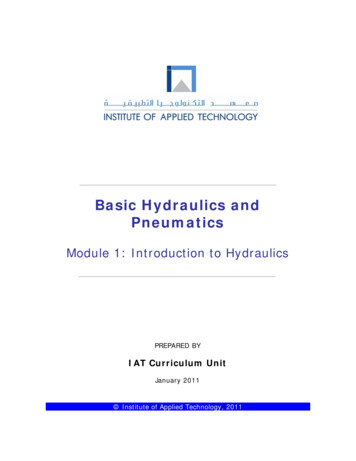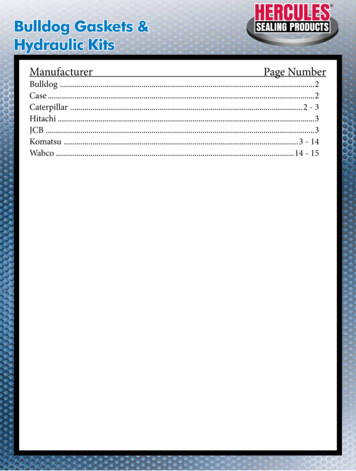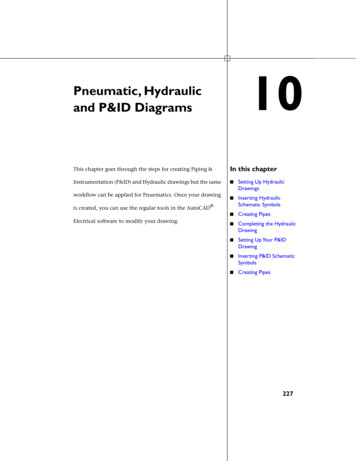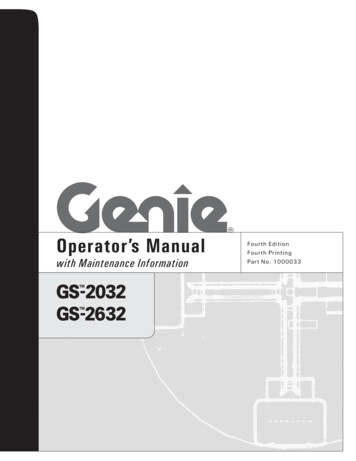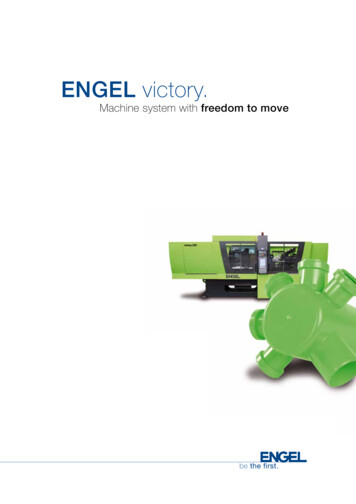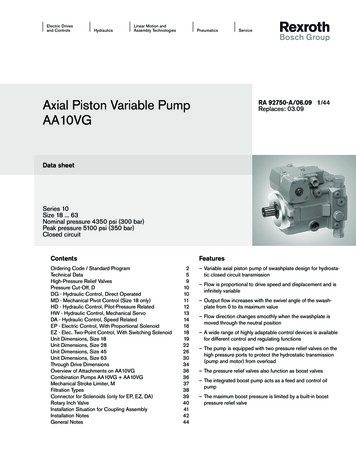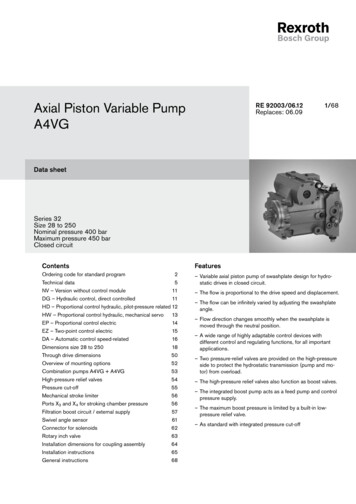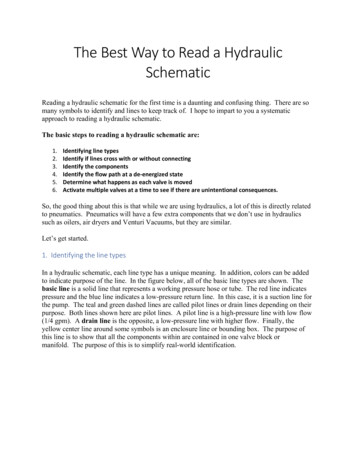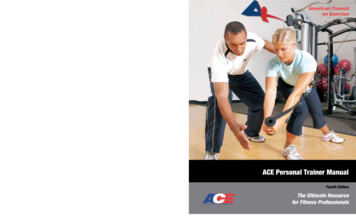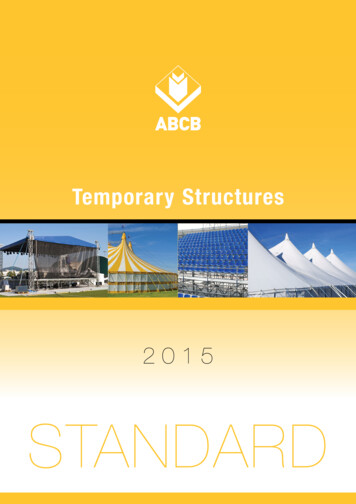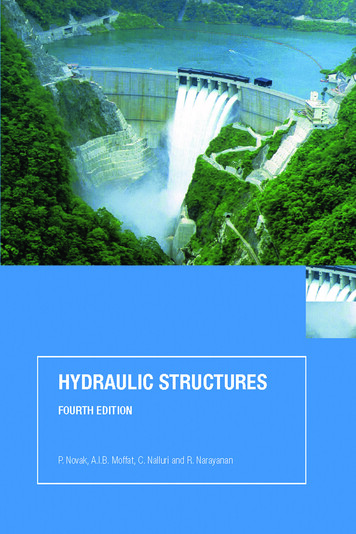
Transcription
Hydraulic Structures
Also available from Taylor & FrancisHydraulics in Civil and Environmental Engineering 4th editionA. Chadwick et al.Hardback: ISBN 978-041-530608-9Paperback: ISBN 978-041-530609-6Mechanics of Fluids 8th editionB. Massey, by J. Ward SmithHardback: ISBN 978-0-415-36205-4Paperback: ISBN 978-0-415-36206-1Practical Hydraulics 2nd editionM. KayHardback: ISBN 978-0-415-35114-0Paperback: ISBN 978-0-415-35115-7Hydraulic CanalsJ. LiriaHardback: ISBN 978-0-415-36211-5Information and ordering detailsFor price availability and ordering visit our website www.sponpress.comAlternatively our books are available from all good bookshops.
Hydraulic StructuresFourth EditionP. Novak, A.I.B. Moffat and C. NalluriSchool of Civil Engineering and Geosciences,University of Newcastle upon Tyne, UKandR. NarayananFormerly Department of Civil and Structural Engineering, UMIST,University of Manchester, UK
Fourth edition published 2007 by Taylor & Francis2 Park Square, Milton Park, Abingdon, Oxon OX14 4RNSimultaneously published in the USA and Canadaby Taylor & Francis270 Madison Ave, New York, NY 10016Taylor & Francis is an imprint of the Taylor & Francis Group, an informa businessThis edition published in the Taylor & Francis e-Library, 2006.“To purchase your own copy of this or any of Taylor & Francis or Routledge’scollection of thousands of eBooks please go to www.eBookstore.tandf.co.uk.” 1990, 1996, 2001, 2007 Pavel Novak, Iain Moffat, the estate of ChandraNalluri and Rangaswami NarayananThe right of Pavel Novak, Iain Moffat, Chandra Nalluri and RangaswamiNarayanan to be identified as the Authors of this Work has been asserted bythem in accordance with the Copyright, Designs and Patents Act 1988All rights reserved. No part of this book may be reprinted or reproduced orutilized in any form or by any electronic, mechanical, or other means, nowknown or hereafter invented, including photocopying and recording, or in anyinformation storage or retrieval system, without permission in writing from thepublishers.The publisher makes no representation, express or implied, with regard to theaccuracy of the information contained in this book and cannot accept any legalresponsibility or liability for any efforts or omissions that may be made.British Library Cataloguing in Publication DataA catalogue record for this book is available from the British LibraryLibrary of Congress Cataloging in Publication DataHydraulic structures / P. Novak . . . [et al.]. — 4th ed.p. cm.Includes bibliographical references and index.ISBN-13: 978-0-415-38625-8 (alk. paper)ISBN-13: 978-0-415-38626-5 (pbk. : alk. paper)1. Hydraulic structures. I. Novák, Pavel.TC180.H95 2007627--dc22ISBN 0-203-96463-2 Master e-book ISBNISBN10: 0-415-38625-X HardbackISBN10: 0-415-38626-8 PaperbackISBN10: 0-203-96463-2 e-bookISBN13: 978-0-415-38625-8 HardbackISBN13: 978-0-415-38626-5 PaperbackISBN13: 978-0-203-96463-7 e-book
ContentsPrefacePreface to the third editionPreface to the second editionxixiiixvPreface to the first editionxviiAcknowledgementsxixList of tablesxxList of main symbolsPart One Dam engineeringxxii11Elements of dam engineering1.1General1.2Introductory perspectives1.3Embankment dam types and characteristics1.4Concrete dam types and characteristics1.5Spillways, outlets and ancillary works1.6Site assessment and selection of type of dam1.7Loads on damsReferences3341216202335392Embankment dam engineering2.1Introduction2.2Nature and classification of engineering soils2.3Engineering characteristics of soils42424247
viCONTENTS2.4Principles of embankment dam design2.5Materials and construction2.6Seepage analysis2.7Stability and stress2.8Settlement and deformation2.9Rockfill embankments and rockfill2.10Small embankment dams, farm dams and flood banks2.11Tailing dams and storage lagoons2.12Geosynthetics in embankment dams2.13Upgrading and rehabilitation of embankment damsWorked Concrete dam engineering3.1Loading: concepts and criteria3.2Gravity dam analysis3.3Buttress dam analysis3.4Arch dam analysis3.5Design features and construction3.6Concrete for dams3.7The roller-compacted concrete gravity dam3.8Upgrading of masonry and concrete damsWorked 84Dam outlet works4.1Introduction4.2The design flood4.3Flood routing4.4Freeboard4.5Sedimentation in reservoirs4.6Cavitation4.7Spillways4.8Bottom outletsWorked 95Energy dissipation5.1General5.2Energy dissipation on spillways5.3Stilling basins5.4Plunge pools5.5Energy dissipation at bottom outletsWorked examplesReferences244244245249259261262264
CONTENTS6Gates and valves6.1General6.2Crest gates6.3High-head gates and valves6.4Tidal barrage and surge protection gates6.5Hydrodynamic forces acting on gates6.6Cavitation, aeration, vibration of gates6.7Automation, control and reliabilityWorked m safety: instrumentation and rveillance7.4Dam safety legislation7.5Reservoir hazard and risk assessmentReferences289289291304306309315Part TwoOther hydraulic structures3198River engineering8.1Introduction8.2Some basic principles of open-channel flow8.3River morphology and régime8.4River surveys8.5Flow-measuring structures8.6River flood routing8.7River improvementWorked iversion works9.1Weirs and barrages; worked examples9.2Intakes; worked examples9.3Fish passesReferences36436439241041610 Cross-drainage and drop structures41810.1Aqueducts and canal inlets and outlets; worked examples 41810.2Culverts, bridges and dips; worked examples42810.3Drop structures; worked example448References458vii
viiiCONTENTS11 Inland waterways11.1Introduction11.2Definitions, classification and some waterways11.3Multipurpose utilization of waterways11.4Transport on inland waterways11.5Canalization and navigation canals11.6Resistance of ships11.7Wave action on banks11.8Locks11.9Thrift locks11.10 Lifts and inclined planes11.11 Lock approaches11.12 Inland portsWorked 849049149349412 Hydroelectric power development12.1Introduction12.2Worldwide hydroelectric power developmentin perspective12.3Power supply and demand12.4Some fundamental definitions12.5Types of water power development12.6Head classification of hydropower plants12.7Streamflow data essential for the assessment ofwater-power potential12.8Hydraulic turbines and their selection12.9Other components of hydropower plants12.10 Surge tanks12.11 Small hydraulic power plant development12.12 Other energy resourcesWorked examplesReferences49649613 Pumping stations13.1Introduction13.2Pumps and their classification13.3Design of pumping mains13.4Classification of pumping stations and intakes13.5Sump design13.6Screening devices13.7Benching13.8Surges13.9General design considerations of pumping stationsand 505517525529530533546566
CONTENTSWorked examplesReferences56857414 Waves and offshore engineering14.1Introduction14.2Wave motion14.3Range of validity of linear theory14.4Waves approaching a shore14.5Wave breaking14.6Wave reflection14.7Basin oscillations14.8Wave diffraction14.9Wave prediction14.10 Wave statistics14.11 Forces on cylindrical structures14.12 Vortex-induced oscillations14.13 Oscillations of cylinders in wavesWorked 960261261761862415 Coastal engineering15.1Introduction15.2Coastal defence15.3Wave forces on coastal structures15.4Wave run-up15.5Wave overtopping15.6Rubble-mound breakwaters15.7Sea outfalls15.8Coastal managementWorked 016 Models in hydraulic engineering16.1Hydraulic models16.2Structural modelsWorked exampleReferences674674683687688Author index691Subject index696ix
PrefaceThe aim of the book, to provide a text for final year undergraduate andpostgraduate students, remains the same as in the previous editions; wealso trust that researchers, designers and operators of hydraulic structureswill continue to find the text of interest and a stimulating up-to-datereference source.This new edition enabled us to update the text and referencesthroughout, and to introduce some important changes and additions reacting to new developments in the field. We have also taken note of somecomments received on the previous edition; particular thanks for the constructive comments and help provided by Professor J. Lewin in redraftingChapter 6 (Gates and valves).The authorship of individual chapters remains the same as in previous editions; (Dr Narayanan carried out the work on this edition duringhis stay in the Faculty of Civil Engineering, Universiti Teknologi Malaysia,Johor Bahru, Malaysia). However, as our colleague Dr C. Nalluri unfortunately died in December 2003 ‘his’ text was reviewed by Dr Narayanan(Chapter 13) and Professor Novak (Chapters 9, 10 and 12) who also againedited the whole text.Readers of the previous (2001) edition may note the following majorchanges:Chapter 1.Chapter 2.Chapter 3.Enhanced discussion of environmental issues including theWorld Commission on Dams report.New sections on partially saturated soils, small farm andamenity dams, tailing dams and lagoons and upgrading andrehabilitation of embankment dams; extended treatment ofupstream face protection/rock armouring.Extended discussion of roller-compacted concrete damsand a new section on upgrading of masonry and concretedams.
xiiPREFACEChapter 4.Chapter 5.Chapter 6.Chapter 7.Chapter 9.Chapter 12.Chapter 14.Chapter 15.Chapter 16.Substantially enhanced discussion of flow over stepped spillways.Extended treatment of scour in plunge pools.Enlarged treatment of hydrodynamic forces acting on lowand high-head gates and new sections dealing with cavitation, aeration and vibrations of gates and automation,control and reliability.Increased coverage of integrated risk analysis/managementand contingency/emergency planning in dam safety.Inclusion of barrages with raised sill.New text on small hydraulic power development and tidaland wave power.More detailed treatment of wave breaking, wave statisticsand pipeline stability.Enhanced treatment of beach profile and wave/structureinteraction and a new section on coastal modelling.Enlarged discussion of mathematical, numerical and computational models in hydraulic engineering.In order not to increase the size of the book unduly some less relevantmaterial has been omitted (particularly in Ch. 12).P. Novak, A.I.B. Moffat and R. NarayananNewcastle upon Tyne, June 2006
Preface to the thirdeditionThe main aim of the book, i.e. to provide a text for final year undergraduate and for postgraduate students, remains the same as for the previoustwo editions; we also hope that researchers, designers and operators of themany types of structures covered in the book will continue to find the textof interest and a stimulating, up-to-date reference source.It is now almost six years since the manuscript of the second editionwas completed and this new edition gave us the opportunity to correct thefew remaining errors and to update the text and references throughout. Atthe same time, as a reaction to some important developments in the field,certain parts of the text have been rewritten, enlarged or reorganized.Readers of the second edition may wish to note the following majorchanges:Chapter 1.Chapter 2.Chapter 4.Chapter 6.Chapter 7.Chapter 9.Chapter 14.The environmental and social issues associated with majorreservoir projects are addressed in greater depth.New section on small embankments and flood banks andexpanded discussion of seismicity and seismic analysis.Enlarged text on design flood selection and reservoir floodstandards, aeration on spillways and in free flowing tunnels;extended treatment of stepped spillways.A new section on tidal barrage and surge protection gatesand enlarged text on forces acting on gates; a new workedexample.Enhanced text on reservoir hazard analysis and dam breakfloods.New paragraph on pressure distribution under piled foundation floors of weirs with a new worked example.This chapter – Coastal and offshore engineering in previousedition – has been divided into:Chapter 14 ‘Waves and offshore engineering’ and
xivPREFACE TO THE THIRD EDITIONChapter 16.Chapter 15 ‘Coastal engineering’Consequently the whole material has been reorganized. Thetreatment of forces on cylindrical bodies in waves and currents has been significantly extended in Chapter 14. Chapter15 now includes an extended treatment of wave overtoppingand stability of breakwaters as well as a brief discussion ofcoastal management.(formerly ch. 15). Extended discussion of computationalmodelling of hydraulic structures.P. Novak, A.I.B. Moffat, C. Nalluri and R. NarayananNewcastle upon Tyne, August 2000
Preface to the secondeditionThe main aim of the book, i.e. to provide a text for final year undergraduate and for postgraduate students, remains the same as for the first edition;equally we hope that researchers, designers and operators of the manytypes of hydraulic structures covered in the book will find the text of interest and a useful reference source.We took the opportunity of a new edition to correct all (known)errors and to thoroughly update the text and references throughout. Atthe same time as a response to received comments and reviews as well as areaction to some new developments in the field, certain parts of the textwere rewritten or enlarged. Readers of the first edition may wish to notethe following major changes.Chapter 1.Chapter 2.Chapter 3.Chapter 4.Chapter 5.Chapter 6.Chapter 7.Chapter 8.Chapter 9.Extended text on site assessment for dams.Expanded treatment of geotechnical aspects, e.g. a newparagraph (2.8.3) on performance indices for earthfill cores,and a new brief section (2.10) on geosynthetics.Extended coverage of RCC dams with a new paragraph(3.7.3) dealing with developments in RCC construction.Enlarged text dealing with design flood estimation, reservoirsedimentation, interference waves and aeration on spillwaysand a new paragraph (4.7.6) on stepped spillways.Enlarged section on scour below spillways.A new paragraph (6.2.8) on overspill fusegates.Enlarged text on reservoir downstream hazard assessment.Enlarged text on multistage channels, geotextiles, Crumpweir computation and a new section (8.6) on river floodrouting.Extended text on fish passes and a new paragraph (9.1.6)on the effect of the operation of barrages on river waterquality.
xviPREFACE TO THE SECOND EDITIONChapter 10.Chapter 13.Chapter 14.Chapter 15.Enlarged text on canal inlets and scour at bridges and belowculvert outlets.A new short section (13.7) on benching.Change of title (from Coastal engineering) to Coastal andoffshore engineering incorporating a substantial new section(14.7) on sea outfalls and the treatment of wave forces onpipelines in the shoaling region.Change of title (from Scale models in hydraulic engineering)to Models in hydraulic engineering to include in the generaldiscussion of hydraulic models (15.1.1) a typology of mathematical models; also included a short paragraph (15.2.4) onmodelling of seismic response.The authors would like to thank the reviewers for their constructive comments and the publisher for providing the opportunity for this secondedition.P. Novak, A.I.B. Moffat, C. Nalluri and R. NarayananNewcastle upon Tyne, December 1994
Preface to the firsteditionThis text is loosely based on a course on ‘Hydraulic Structures’ whichevolved over the years in the Department of Civil Engineering at the University of Newcastle upon Tyne. The final-year undergraduate andDiploma/MSc postgraduate courses in hydraulic structures assume a goodfoundation in hydraulics, soil mechanics, and engineering materials, andare given in parallel with the more advanced treatment of these subjects,and of hydrology, in separate courses.It soon became apparent that, although a number of good books maybe available on specific parts of the course, no text covered the requiredbreadth and depth of the subject, and thus the idea of a hydraulic structurestextbook based on the course lecture notes came about. The hydraulicstructures course has always been treated as the product of team-work.Although Professor Novak coordinated the course for many years, he andhis colleagues each covered those parts where they could make a personalinput based on their own professional experience. Mr Moffat, in particular,in his substantial part of the course, covered all geotechnical engineeringaspects. In the actual teaching some parts of the presented text may, ofcourse, have been omitted, while others, particularly case studies (includingthe discussion of their environmental, social, and economic impact), mayhave been enlarged, with the subject matter being continuously updated.We are fully aware that a project of this kind creates the danger ofpresenting the subject matter in too broad and shallow a fashion; we hopethat we have avoided this trap and got it ‘about right’, with workedexamples supplementing the main text and extensive lists of referencesconcluding each chapter of the book.This text is not meant to be a research monograph, nor a designmanual. The aim of the book is to provide a textbook for final-yearundergraduate and postgraduate students, although we hope thatresearchers, designers, and operators of the many types of hydraulic structures will also find it of interest and a useful reference source.
xviiiPREFACE TO THE FIRST EDITIONThe text is in two parts; Part One covers dam engineering, and PartTwo other hydraulic structures. Mr A.I.B. Moffat is the author of Chapters 1, 2, 3 and 7, and of section 15.2. Dr C. Nalluri wrote Chapters 9, 10,12 and 13, and sections 8.4 and 8.5. Dr R. Narayanan of UMIST wasinvited to lecture at Newcastle for two years, on coastal engineering, and isthe author of Chapter 14. The rest of the book was written by ProfessorP. Novak (Chapters 4, 5, 6 and 8, except for sections 8.4 and 8.5, Chapter11 and section 15.1), who also edited the whole text.P. Novak, A.I.B. Moffat, C. Nalluri and R. NarayananNewcastle upon Tyne, 1989
AcknowledgementsWe are grateful to the following individuals and organizations who havekindly given permission for the reproduction of copyright material (figurenumbers in parentheses):Thomas Telford Ltd (4.1, 4.2); US Bureau of Reclamation (4.3, 4.7,4.15, 4.16, 5.6, 5.7); Elsevier Science Publishers (4.5, 4.12, 4.13, 5.5, 5.8,5.10. 11.1, 11.2, 11.10, 11.11, 11.16, 11.17, 11.18, 12.17); British Hydromechanics Research Association (4.11, 13.6, 13.9); Institution of Waterand Environmental Management (4.18); ICOLD (4.19, 4.20); Figures 4.21,6.2, 6.3, 6.4 reproduced by permission of John Wiley & Sons Ltd, fromH.H. Thomas, The Engineering of Large Dams, 1976; C.D. Smith (6.6,6.7); MMG Civil Engineering Systems Ltd (8.20); E. Mosonyi (9.12, 9.13,12.17); International Institute for Land Reclamation and Improvement,the Netherlands (10.14, 10.15); Morgan-Grampian Book Publishing (11.1,11.5); Delft Hydraulics (11.7); Macmillan (14.12); C.A.M. King (14.13);C. Sharpe (11.2); J. Lewin (6.1, 6.2).Cover image courtesy of Ingetec S.A. Colombia (Dr A. Marulanda)
List of 83.13.23.33.43.53.63.73.83.93.103.114.17.1Large dams: World Register statisticsSummary of numbers of British, US and Chinese damsHighest damsLargest-volume damsDams with largest-capacity reservoirsNotional foundation stresses: dams 100 m in heightDam selection: type characteristicsRepresentative physical characteristics of soilsDescriptive consistency of clay soilsIllustrative engineering properties for selected soil typesEmbankment dam defect mechanisms and preventivemeasuresCharacteristics of core soilsIndicative engineering properties for compacted earthfillsGuideline factors of safety: effective stress stability analysisSeismic acceleration coefficients, h, and earthquakeintensity levelsSeismic pressure factors, CeNominated load combinationsRange of shearing resistance parametersFoundation rock shear strength characteristicsExamples of shear strength degradationRecommended shear friction factors, FSFComparative sliding stability factors: triangular gravity profilePermissible compressive stressesIllustrative values for coefficient, K0Characteristics of mass concrete for damsCharacteristics of RCCs for damsFlood, wind and wave standards by dam categorySelected major dam disasters 8141143147154173177194290
LIST OF 516.1Primary monitoring parameters and their relationship topossible defectsRepresentative monitoring frequenciesTypes of weirCorrection factors for submerged (non-modular) flowsValues of for parallel flowTypes of flow in the barrel of a culvertBridge loss coefficient, KBValues of K as a function of pier shapeValues of KN and KAPermissible velocities to withstand erosionRange of values of C for free flow over the embankmentCorrection factor, f (non-modular flows)Freight on inland waterways: annual throughput of shippingRange of values, specific speeds and headsQ–H–Ns dataRunaway speeds and acceptable head variationsCritical plant sigma values, cTypes of pumps and their applicationsSpecific speeds for rotodynamic pumpsSludge flow head lossesFactor r for various armour unitsValues of coefficients A and B for simple sea wallsValues of KD in Hudson’s formula (SPM): no damageand minor overtoppingLayer coefficient K D and porosity for various armour unitsVariation in damage number for failure conditionsScale 09510511550551568644646649650652680xxi
Main symbolsaAbBBcCCdCDCvdDEefFFDFrFSLgGWLh hHHsHFLiIconstant, gate opening, pressure wave celerity, wave amplitudecross-sectional areabreadth, channel width, constant, length of wave crestwater surface widthporewater pressure coefficientapparent cohesion, coefficient, constant, unit shearing strength,wave celerityChezy coefficient, coefficient, concentrationcoefficient of dischargedrag coefficientcoefficient of consolidation, coefficient of velocitydepth, diameter, sediment grain sizediameter, displacement of vesselscut-off (core) efficiency, energy, Young’s modulusenergy loss, pipe wall thicknesscorrection factor, frequency, function, Lacey’s silt factorfactor of safety, fetch, force, functiondrag forceFroude numberfull supply levelgravitational accelerationground water leveluplift pressure headhead, pump submergence, rise of water level above SWL, stagetotal energy (head), head (on spillway etc.), wave (embankment)heightseepage head, significant wave height, static lifthigh flood levelhydraulic gradientinflow, influence factor, moment of inertia
MAIN S0ShSWLtTuuwUU* VVcwwsWcoefficient (of permeability), effective pipe roughness, wavenumberbulk modulus, channel conveyance, coefficientKeulegan–Carpenter numberlengthlength, wavelengthmasscoefficient of volume compressibilitymomentManning roughness coefficienthydraulic exponent speed in rev/minnumber of increments of potential in flownetnumber of flow channels in flownetspecific speednormal water leveloutflownumber of poles, pressure intensityvapour pressureforce, power, wetted perimeterspecific dischargedischargedischarge of sedimentfactor, radiuspore pressure ratiohydraulic radius, resistance, resultant, radiusReynolds numberrégime scour depthmaximum shearing resistance, slopecritical slopefriction slopebed slopeStrouhal numberstill water levelthickness, timedraught, time, wave periodlocal velocity (x direction)porewater pressurewind speedshear velocityvelocity (general), velocity (y direction)mean cross-sectional velocity, storage, volumecritical velocitymoisture content, velocity (z direction)sediment fall velocityrégime width, weightxxiii
xxivMAIN SYMBOLSxyy y ycymysz µv s 1,2,3 c 0 distance, x coordinateflow depth, y coordinatestilling basin depthdepth of centroid of section Acritical depthmean depth ( A/B)maximum scour (local) depth, turbine settingdepth, elevation relative to datum, z coordinateangle, constant, energy (Coriolis) coefficient, (seismic)coefficient, wave crest angleangle, momentum (Boussinesq) coefficient, slope, anglespecific (unit) weight ( pg)boundary layer thickness, deflection settlementlaminar sublayer thickness)/ )relative density of sediment in water (( sstrainarea reduction coefficient, efficiencyangle, velocity coefficientDarcy–Weisbach friction factor, flownet scale transform factordynamic viscosity of waterkinematic viscosity of water, Poisson ratiocoefficient (head loss), parameterdensity of waterdensity of sediment particlecavitation number, conveyance ratio, safety coefficient, stress,surface tensionmajor, intermediate and minor principal stresseseffective stress, safety coefficientshear stress, time intervalcritical shear stressboundary shear stressangle of shearing resistance or internal friction, function,sediment transport parameter, speed factorflow parameterangular velocity (radians s 1)
Part OneDam engineering
Chapter 1Elements of damengineering1.1GeneralThe construction of dams ranks with the earliest and most fundamental ofcivil engineering activities. All great civilizations have been identified withthe construction of storage reservoirs appropriate to their needs, in theearliest instances to satisfy irrigation demands arising through the development and expansion of organized agriculture. Operating within constraints imposed by local circumstance, notably climate and terrain, theeconomic power of successive civilizations was related to proficiency inwater engineering. Prosperity, health and material progress becameincreasingly linked to the ability to store and direct water.In an international context, the proper and timely utilization of waterresources remains one of the most vital contributions made to society bythe civil engineer. Dam construction represents a major investment inbasic infrastructure within all nations. The annual completion rate fordams of all sizes continues at a very high level in many countries, e.g.China, Turkey and India, and to a lesser degree in some more heavilyindustrialized nations including the United States.Dams are individually unique structures. Irrespective of size andtype they demonstrate great complexity in their load response and in theirinteractive relationship with site hydrology and geology. In recognition ofthis, and reflecting the relatively indeterminate nature of many majordesign inputs, dam engineering is not a stylized and formal science. Aspractised, it is a highly specialist activity which draws upon many scientificdisciplines and balances them with a large element of engineering judgement; dam engineering is thus a uniquely challenging and stimulating fieldof endeavour.
4ELEMENTS OF DAM ENGINEERING1.2Introductory perspectives1.2.1Structural philosophy and generic types of damsThe primary purpose of a dam may be defined as to provide for the saferetention and storage of water. As a corollary to this every dam must represent a design solution specific to its site circumstances. The design therefore also represents an optimum balance of local technical and economicconsiderations at the time of construction.Reservoirs are readily classified in accordance with their primarypurpose, e.g. irrigation, water supply, hydroelectric power generation,river regulation, flood control, etc. Dams are of numerous types, and typeclassification is sometimes less clearly defined. An initial broad classification into two generic groups can be made in terms of the principal construction material employed.1.2.Embankment dams are constructed of earthfill and/or rockfill. Upstreamand downstream face slopes are similar and of moderate angle, giving awide section and a high construction volume relative to height.Concrete dams are constructed of mass concrete. Face slopes are dissimilar, generally steep downstream and near vertical upstream, anddams have relatively slender profiles dependent upon the type.The second group can be considered to include also older dams of appropriate structural type constructed in masonry. The principal types of damswithin the two generic groups are identified in Table 1.1. Essentialcharacteristics of each group and structural type are detailed further inSections 1.3 and 1.4.Embankment dams are numerically dominant for technical and economic reasons, and account for an estimated 85–90% of all dams built.Older and simpler in structural concept than the early masonry dam, theTable 1.1Large dams: World Register statistics (ICOLD, 1998)GroupTypeICOLD codeEmbankment iple archPGVACBMVConcrete dams(including masonrydams)Total large dams%冧82.911.34.41.00.441 413
INTRODUCTORY PERSPECTIVESembankment utilized locally available and untreated materials. As theembankment dam evolved it has proved to be increasingly adaptable to awide range of site circumstances. In contrast, concrete dams and theirmasonry predecessors are more demanding in relation to foundation conditions. Historically, they have also proved to be dependent upon relatively advanced and expensive construction skills and plant.1.2.2Statistical perspectiveStatistics are not available to confirm the total number of dams in serviceworldwide. Accurate statistical data are confined to ‘large’ dams enteredunder national listings in the World Register of Dams, published by theInternational Commission on Large Dams.ICOLD is a non-governmental but influential organization representative of some 80 major dam-building nations. It exists to promote theinterchange of ideas and experience in all areas of dam design, construction, and operation, including related environmental issues. La
Alternatively our books are available from all good bookshops. Hydraulic Structures Fourth Edition P. Novak, A.I.B. Moffat and C. Nalluri School of Civil Engineering and Geosciences, University of Newcastle upon Tyne, UK and R. Narayanan Formerly Department of Civil and Structural E
